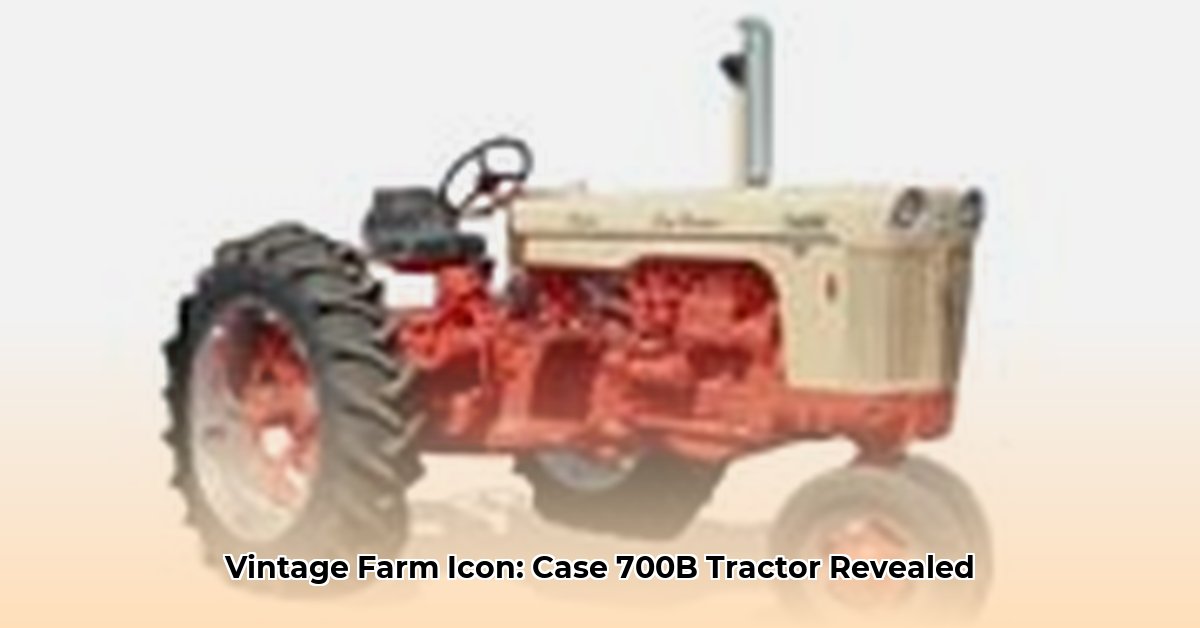
The Case 700B tractor: a name whispered with reverence among vintage tractor enthusiasts. This wasn't just another farm machine; it was a symbol of rugged durability and innovative engineering, a testament to a bygone era when quality reigned supreme. But its story is more than just nuts and bolts; it's a captivating tale of limited production, unique design choices, and a legacy that continues to fascinate. For more on modern Case tractors, check out Case IH Tractors.
Case 700B Tractor: A Rare Find in Agricultural History
The J.I. Case 700B tractor stands out not for its widespread popularity, but for its remarkable scarcity. With an estimated production run of only around 143 units, finding one today is akin to discovering a hidden treasure. This limited production raises intriguing questions: was it a market miscalculation? A design quirk? Or perhaps, a perfect storm of unforeseen circumstances? Whatever the reason, this rarity has only added to the 700B's allure, captivating collectors and history buffs worldwide. Did the limited production contribute to its current legendary status?
Power and Choice: Engine and Chassis Options
Unlike many tractors of its time, the Case 700B offered farmers a choice: gasoline or diesel power. This adaptability catered to the varied fuel availability and individual preferences of the era. The options didn't end there. Farmers could also select from multiple chassis configurations: standard, row-crop, Western, and high-crop—a testament to Case's understanding of the diverse needs of their agricultural clientele. This flexibility ensured the 700B could adapt to different terrains and crop types, a powerful selling point in its time.
The Dual-Range Transmission: A Reliable Heart
The 700B’s Dual-Range 8-speed transmission, while simpler than the later Case-O-Matic systems, was renowned for its robustness and reliability. This choice reveals a prioritization of enduring functionality over cutting-edge technology, showcasing a different approach to engineering prevalent at the time. The Dual-Range transmission was a reliable workhorse, reflecting Case's commitment to building machines that could withstand the rigors of daily farm life. How did this design choice influence the tractor's longevity and reputation for durability?
A Photographic Enigma: The 700B's Elusive Images
Sadly, comprehensive documentation of the Case 700B remains scarce. Finding photographs is a challenge, further intensifying the tractor's mystique. This lack of readily available information underscores the need for greater preservation efforts. The scarcity of images only adds to the mystery, making each surviving 700B an even more valuable piece of history. What steps can be taken to ensure future generations have access to this important piece of agricultural heritage?
Preserving the Legacy: The Case 700B's Enduring Importance
The rarity of the Case 700B presents unique challenges for preservation. Parts are difficult to find, and restoration can be a costly endeavor. Yet, the rewards—the opportunity to preserve a vital piece of agricultural history—are immeasurable. Museums, collectors, and enthusiasts all play a critical role in safeguarding this legacy. Collectively, we must document, preserve, and celebrate this often-overlooked machine to ensure its story isn't lost to time. The task of preservation rests on all of us.
Case 700B: Key Features at a Glance
This table summarizes the key features of the Case 700B tractor:
| Feature | Description | Significance |
|---|---|---|
| Engine | Gasoline or Diesel options | Farmer choice based on fuel availability and preference. |
| Transmission | Dual-Range 8-speed | Reliable and effective, although simpler than later models. |
| Chassis | Standard, Row-crop, Western, High-crop options | Adaptable to various farming situations and terrains. |
| Production Run | Approximately 143 units | Remarkably low production run compared to other Case tractors. |
The Case 700B, although rare, stands as a significant milestone in agricultural machinery history. Its limited production, distinctive features, and the captivating mystery surrounding its heritage make it a true icon, representing a pivotal moment in the evolution of farm technology. Its story deserves to be remembered and celebrated.